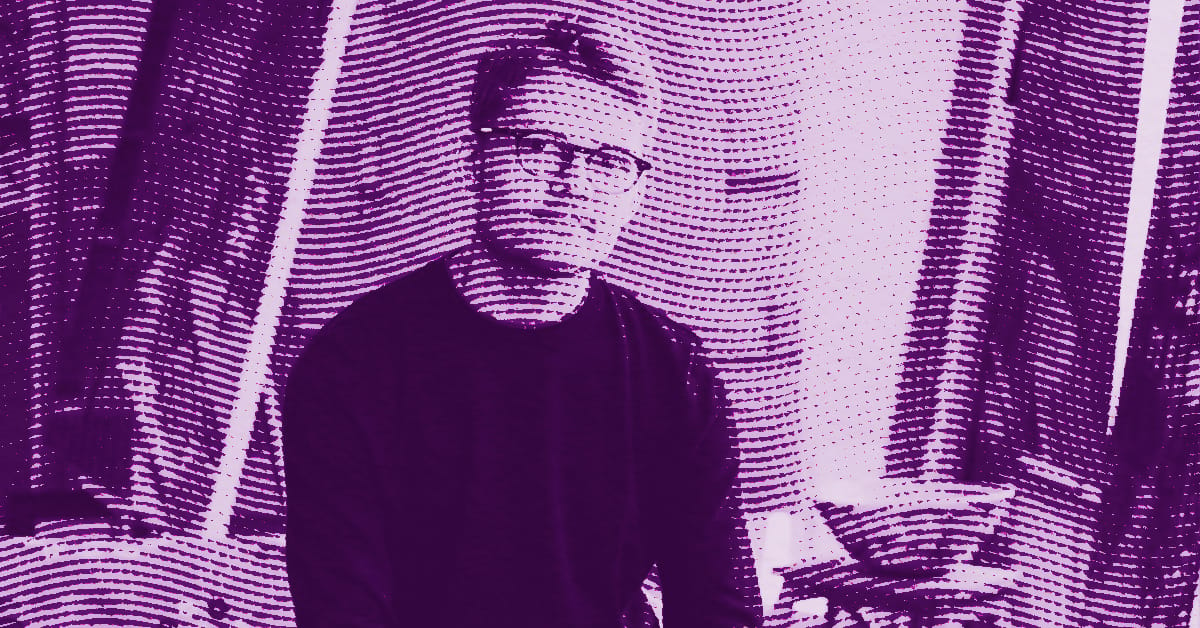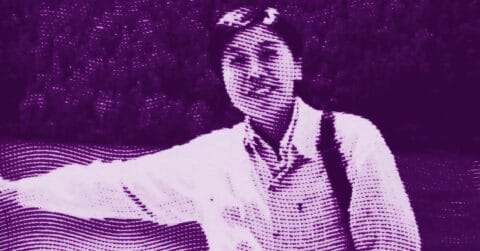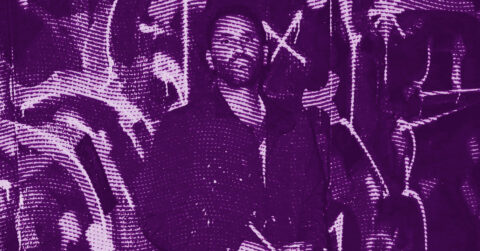Listen to me carefully, you bunch of snobs, Alfie Caine does not paint houses, he builds dreams. This young British man of almost thirty, a graduate in architecture from Cambridge, abandoned urban planning blueprints to erect cathedrals of the intimate, domestic spaces bathed in a light that exists only in the most persistent dreams. In his recent New York exhibition “The Chalk Carver’s House” at Margot Samel, Caine offers us seven paintings dated 2025 that attest to a striking artistic maturity [1]. These works are not mere depictions of bourgeois interiors; they constitute a silent manifesto on contemporary solitude and our obsessive relationship to the spaces we inhabit.
The artist, settled in the small town of Rye in East Sussex since 2020, draws his inspiration from the English coastal landscapes that he transforms into psychedelic visions [2]. Born in 1996, Caine studied architecture at the University of Cambridge where he graduated in 2018, winning several prestigious prizes including the Purcell Prize for his exceptional drawing and representational skills [3]. His colors, incandescent fuchsia, canary yellow and candy-pink, defy any naturalistic plausibility to create a distinctly contemporary pictorial language. Caine does not content himself with painting what he sees; he reinvents reality according to his own chromatic codes, creating environments where the impossible becomes familiar.
The strength of Caine’s work lies in his ability to combine architectural precision with poetic freedom. His academic background at Cambridge shows through in every straight line, every controlled perspective, every meticulously orchestrated furnishing detail. But where traditional architecture seeks functionality, Caine favors emotion. His interiors, kitchens with immaculate tiles, staircases with sculpted banisters and living rooms with panoramic windows, function like theatrical sets awaiting their actors.
This theatrical dimension is not accidental. Trained in the principles of spatial composition, Caine intuitively understands that architecture is never neutral: it conditions our movements, our moods, our social interactions. In “Golden Hills”, one of the centerpiece works of the exhibition, we observe a miniature house framed by an open door, itself bounded by a tropical flower and the silhouette of a dog [1]. This architectural mise en abyme reveals the artist’s conceptual sophistication: he does not merely show a space; he questions the way we look at it.
The influence of his architectural training also manifests itself in his mastery of perspective and light. Each of Caine’s canvases functions like an architect’s plan translated into pictorial language, where every element, from furniture to decorative objects, occupies a calculated position. This compositional rigor, inherited from his years studying proportions and volumes, gives his works an undeniable structural solidity. Yet this rational framework paradoxically serves to carry an irrational vision of the domestic world.
The artist excels in the art of meaningful detail: two bananas in a bowl, a partially visible pet, an ajar door. These elements, seemingly innocuous, reveal an intimate knowledge of how architecture influences our daily behaviors. Caine knows that our homes shape us as much as we shape them, and his paintings explore this complex dialectic between the inhabitant and his habitat. His architectural training allows him to understand that domestic space is never innocent: it bears the traces of our aspirations, our fears, our repressed desires.
This architectural approach to painting places Caine in a lineage of artists who have explored the links between construction and creation. But where his predecessors often sought monumentality, he favors intimacy. His spaces are never grand; they remain human in scale, accessible, familiar. This dimensional modesty reveals a profound understanding of domestic architecture as refuge rather than as a demonstration of power.
Caine’s work also engages with an English literary tradition deeply rooted in exploring the relationships between myth and territory. His exhibition “The Chalk Carver’s House” takes as its starting point the Litlington White Horse, that equestrian figure carved into the chalk of the Sussex hills [1]. This reference is not incidental: it reveals the artist’s fascination with the narratives inscribed in the landscape, with those stories the land itself tells.
The British literary tradition, from Geoffrey Chaucer to Thomas Hardy, through romantics like William Wordsworth, has always maintained a privileged relationship with the genius loci, that spirit of place that transforms geography into poetry. Caine situates himself in this lineage by transforming his observations of the Sussex landscape into pictorial visions charged with mystery. Like the writers of the English countryside, he knows that every hill, every river, every path carries centuries-old stories within it.
The myth of the chalk horse, as Caine explores it, perfectly illustrates this literary conception of the landscape as narrative testimony. The artist reminds us that this geoglyph, probably created by a nineteenth-century farmer and his sons, has been reshaped over the decades by different hands [1]. This stratification of human interventions on the territory evokes how popular narratives are constructed: by accumulation, transformation, reinterpretation.
Caine transposes this narrative logic into his painting by creating spaces that seem to contain multiple temporal layers. His interiors blend contemporary and timeless references, familiar objects and enigmatic elements. This layered approach to pictorial composition reveals a literary understanding of the image: each canvas functions as an open narrative, capable of multiple and contradictory readings.
The mythological dimension underpinning Caine’s work belongs to an English literary tradition that has always privileged the exploration of imaginary territories. From Lewis Carroll to J.R.R. Tolkien, through the fantastical tales of M.R. James, British literature excels at creating parallel worlds that obliquely comment on our reality. Caine proceeds similarly by constructing domestic spaces that operate as heterotopias, those other places dear to Michel Foucault.
His paintings reveal a literary sensibility in their treatment of human absence. As in certain Henry James stories where the essential meaning is played out in what is left unsaid, Caine’s spaces speak of their inhabitants through their mere material presence. A working shower in “Shower Mist”, lights turned on, smoke escaping from a chimney: all these narrative clues act like literary metonymies [2]. The artist masters the art of suggestion, that fundamental technique of modern storytelling which consists of saying more by showing less.
This narrative approach to painting reveals a deep understanding of the mechanisms of fiction. Caine knows that the best stories leave a degree of darkness, a space for projection for the reader, or in his case, for the viewer. His canvases function like the openings of short stories whose continuations we must imagine, fragments of larger narratives that unfold beyond the pictorial frame.
The influence of the English literary tradition also manifests in his treatment of temporality. His works seem captured in an eternal present, a moment suspended between day and night, between presence and absence. This temporal ambiguity evokes the stories of Virginia Woolf or Katherine Mansfield, where dramatic action gives way to the exploration of the psychological instant. Caine paints domestic epiphanies, those moments of silent revelation that punctuate our daily life.
The artist also reveals a literary sensibility in his approach to the question of the gaze. His windows and doors are not mere architectural openings: they function as narrative devices that organize our perception of space. This staging of the gaze evokes the narrative techniques of the modern novel, where focalization determines our understanding of the plot. Caine consistently places us in the position of a benevolent voyeur, a privileged observer of domestic scenes that seem to be waiting for us.
This voyeuristic dimension of his work converses with a long literary tradition of exploring bourgeois intimacy. Like the realist novelists of the nineteenth century, Caine is interested in the revealing details of everyday life: the arrangement of objects on a table, the choice of colors in an interior, the way light enters a room. These elements, apparently insignificant, compose in his work a subtle sociological portrait of the contemporary middle class.
The exhibition “The Chalk Carver’s House” reveals Caine’s artistic maturity in his ability to weave together architectural references and literary inspirations. His three central canvases, “Chalk Horse”, “Nine Legs” and “Golden Hills”, function like a narrative triptych where each panel illuminates the others [2]. This serial conception of painting reveals a cinematic approach that owes much to the editing techniques developed by the seventh art.
The artist excels in the art of visual transition: the river that runs through his three main canvases functions like a narrative thread, an element of continuity that unifies the whole [2]. This mastery of pictorial narration attests to a sophisticated understanding of the links between image and story, between representation and fiction.
Beyond its undeniable formal qualities, Caine’s work questions our contemporary relationship to domestic space. At a time when the pandemic has transformed our homes into offices, schools, gyms, his paintings remind us of the poetic dimension of dwelling. They invite us to rediscover the beauty of those familiar spaces that we pass through without seeing them.
Caine belongs to that generation of artists who grew up with Instagram and have an intuitive grasp of the codes of digital imagery. His early commercial successes were, moreover, built through social media [2]. Yet his paintings resist the logic of instant visual consumption that characterizes our era. They demand time, attention, contemplation.
This resistance to contemporary acceleration may be the most radical aspect of his work. In a world saturated with ephemeral images, Caine offers enduring visions, spaces where one would like to linger. His interiors function as visual refuges, havens of peace amid the surrounding media chaos.
The artist also reveals a keen awareness of contemporary ecological issues in the way he depicts nature. His landscapes, though idealized, testify to a deep love for the English countryside threatened by rampant urbanization. His saturated colors, as critic Kate Mothes notes, create an “ethereal light” that transforms ordinary domestic spaces into environments charged with mystery [4]. By settling in Rye, a small town of fewer than 5,000 inhabitants, Caine chose a slower, more contemplative life. That existential choice is reflected in his works, which celebrate the beauty of peripheral territories.
His saturated colors, far from being gratuitous, reveal an intent to emotionally recharge spaces that habit has made invisible. By turning a banal staircase into a pink-and-orange cascade, by metamorphosing an ordinary kitchen into a chromatic laboratory, Caine reminds us that beauty can emerge anywhere, provided one knows how to look.
The exhibition at Margot Samel confirms Alfie Caine’s place in the international art landscape. His works will soon dialogue with those of established artists in private and public collections. But beyond commercial success, it is the coherence of his vision that impresses: that of a young man who has managed to transform his childhood nostalgia into an adult, sophisticated pictorial language.
Caine proves to us that it is still possible, in 2025, to believe in painting as a means of knowing the world. His canvases do not merely decorate our walls: they transform the way we inhabit our spaces, how we look at our interiors, and how we dream our homes. That is already much; it may be essential. This is truly great art.
- Brooklyn Rail, “Alfie Caine: The Chalk Carver’s House”, 2025
- Artsy, “In Alfie Caine’s Paintings, Dreamy Interiors Meet Surreal Landscapes” by Olivia Horn, 2025
- Official website of the artist, alfiecaine.com, “About” section, site visited in August 2025.
- Colossal, “Ethereal Light Suffuses Domestic Interiors with Surreal Hues in Alfie Caine’s Paintings” by Kate Mothes, 2023
















